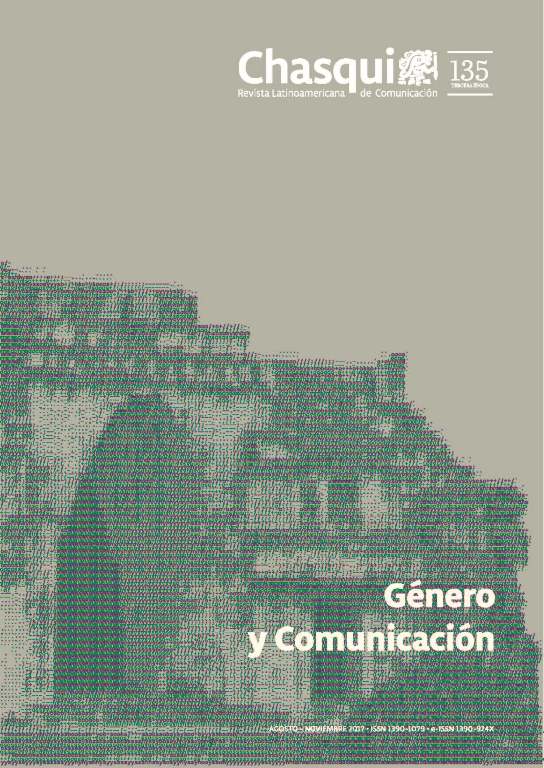Selfies in Tinder: hegemonic masculinities as performance
DOI:
https://doi.org/10.16921/chasqui.v0i135.3170Keywords:
selfies, masculinities, smartphones, performanceAbstract
The article explores how the selfies promote hegemonic masculinities in cyberspace presented in the most popular relationship application around the world, Tinder, and how these men relate to the smartphone to manage male performances from self-image. It seeks to comprehend how gender and subjectivities build the self by the habitus shared among men and how these identities can be perceived by the image in the construction of a profile in a mobile device application. Through a multisite ethnography, ten profiles were analyzed from August 2015 to March 2017. The study is a contribution to the field of masculinities and gender identities crossed by the online network.References
Bourdieu, P. (1998). A dominação masculina. Rio de Janeiro: Bertrand Brasil.
Butler, J. (2003). Problemas de gênero: feminismo e subversão da identidade. Rio de Janeiro: Civilização Brasileira.
Cechetto, F. R. (2005). Violência e estilos de masculinidade. São Paulo: FVG Editora.
Connell, R. (2013). Masculinidade hegemônica: repensando o conceito. Florianópolis: Revista Estudos Feministas.
Crane, D. (2006). A moda e seu papel social – classe, gênero e identidade nas roupas. São Paulo: SENAC.
David, D. & Brannon, R. (1976). The Forty-nine Percent Majority: The Male Sex Role. New York: New York Penguin Books.
Durand, G. (2002). Estruturas antropológicas do imaginário. São Paulo: Martins Fontes.
Farrell, W. (2013 [1974]). The liberated man: Freeing men and their relationships with women. New York: Random House.
Feigen-Fasteau, M. (1974). The male machine. New York: Mac Graw-Hill.
Harvey, J. (2004). Homens de Preto. São Paulo: UNESP.
Jeolás, L. & Kordes, H. (2010). Percursos acelerados de jovens condutores ilegais: o risco entre vida e morte, entre jogo e rito. Porto Alegre: Horizontes Antropológicos.
Heilborn, M. L. & Carrara, S. (1998). Dossiê Masculinidade. Em cena, os homens... Revista Estudos Feministas, 6(2), 270-421.
Kimmel, M. (1998). The gender of desire: essays on masculinity. USA: New York Press.
Kimmel, M. & Aronson, A. (2003). Men and masculinities: a social, cultural and historical encyclopedia. New York: The New York Public.
Kupers, T. A. (2005). Toxic masculinity as a barrier to mental health treatment in prison. Journal of Clinical Psychology, 61(6), 713-724.
Latour, B. (2008). Reensamblar lo social: una introducción a la teoria del actor-red. Buenos Aires: Manantial.
Le Breton, D. (2013). Adeus ao corpo: Antropologia e sociedade. Campinas: Papirus.
Marcus, G. E. (2001). Etnografía en/del sistema mundo – el surgimiento de la etnografía multilocal. México DF: Alteridades.
Pleck, J. H., & Sawyer, J. (Eds.). (1974). Men and masculinity. Prentice Hall.
Robles, E.; Peretz, A. & Kohli, S. (2016). Fear of the other and toxic masculinity in the age of Trump. Berkeley: Haas Institute.
Scott, J. (1995). Gênero: uma categoria útil de análise histórica. Educação & Realidade, 20(2), 71-99.
Simão, L. de A. & Mesquita, C. (2010). O terno: questões e reflexões. São Paulo: Design, Arte, Moda e Tecnologia.
Strathern, M. (2014). O efeito etnográfico. São Paulo: CosacNaify.
Downloads
Published
Issue
Section
License
- Authors retain copyright and grant the journal right of first publication with the work simultaneously licensed under a Creative Commons Attribution-NoDerivs License (CC BY-ND) that allows others to share the work with an acknowledgement of the work's authorship and initial publication in this journal.
- Authors are able to enter into separate, additional contractual arrangements for the non-exclusive distribution of the journal's published version of the work (e.g., post it to an institutional repository or publish it in a book), with an acknowledgement of its initial publication in this journal.
- Authors are permitted and encouraged to post their work online.

